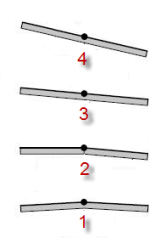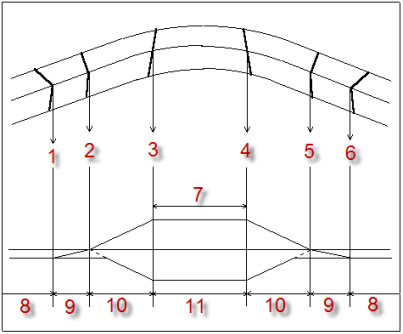Understanding Superelevations
"Superelevation" is the banking of a road along a horizontal curve so motorists can safely and comfortably maneuver the curve at reasonable speeds. As speeds increase and horizontal curves become tighter, a steeper superelevation rate is required.
A superelevated section of a road includes two transition sections on approach, and the same two transition sections in reverse order on departure:
- On approach:
- Tangent runout - The length of the road needed to transition from the normal crown (1) section to the point at which the outside lane has zero (flat) cross slope (2 below).
- Superelevation runoff - The length of the road needed to transition from a zero (flat) cross slope for the outside lane (2 below), to the crown being removed (3), and, finally, to full superelevation (4 below).
- On departure:
- Superelevation runoff - The length of the road needed to transition from full superelevation (4 below), to the crown being re-added (3),and, finally, to a zero (flat) cross slope for the outside lane (2).
- Tangent runout - The length of the road needed to transition from the point at which the outside lane has zero (flat) cross slope (2 below) to the normal crown (1) section.

When you superelevate a curve, you specify the cross slope for the normal crown and the maximum slope in the curve. You then specify the length of the runoff and runout sections in the approach to, and departure from, the curve. You also specify the amount of runoff you want to occur in the curve itself. For example, you might specify that 30% of the approach runoff section occurs in the curve, while 70% occurs prior to the curve in the tangent.
If necessary, you can provide rollover parameters to a superelevated curve to ensure that slope differences between segments (for example, a driving lane and a shoulder) are kept to a minimum for safety and comfort.
The following figure shows the components of a typical superelevation transition. The top half of the figure shows the segments in the curve. The bottom half of the figure shows the superelevation profile diagram. This diagram illustrates how the slope changes for the inside (bottom line; negative slope) and outside (top line; positive slope) edges of the road through each station in the curve.

Key:
|
1. Begin transition from normal crown |
7. Outside lane full superelevation |
|
2. Adverse crown removed |
8. Normal crown section |
|
3. Begin full superelevation |
9. Tangent runout |
|
4. End full superelevation |
10. Superelevation runoff |
|
5. Adverse crown re-added |
11. Inside lane full superelevation |
|
6. End transition and return to normal crown |
|
Once a superelevation is created for a horizontal alignment, you can apply it to a corridor template as part of the definition of the corridor.